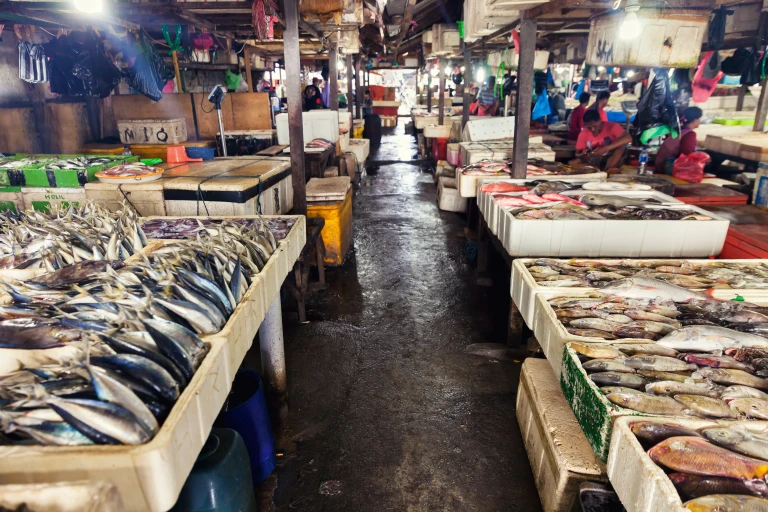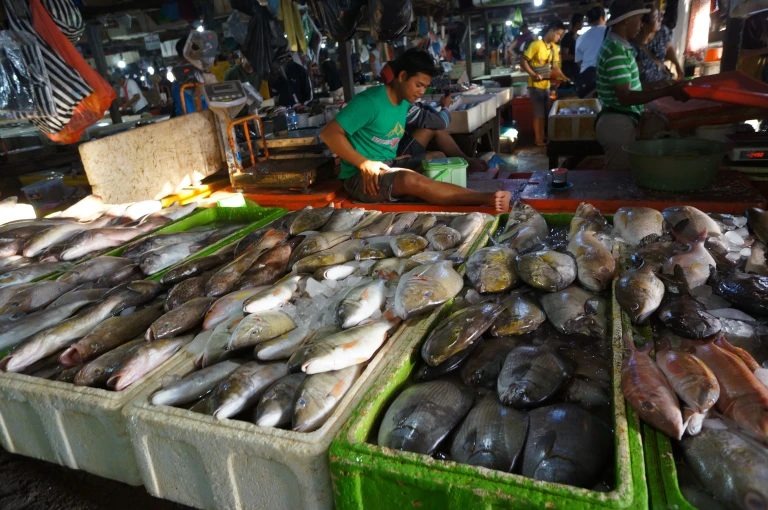What does the fish market represent?

The Jimbaran Fish Market (Kedonganan Fish Market). Hundreds of tourists and locals choose this place to buy fresh seafood every day. For those unfamiliar with the diversity of the local underwater fauna, navigating this market can be challenging. So, for those who want a positive experience, our article. Territorially, the Jimbaran Fish Market is located slightly south of the airport on the western side of the isthmus connecting Bukit to the main part of the island.
Kedonganan Fish Market is precisely what you're looking for on the map, and a navigator will lead you there without problems. Parking for cars is organized at the entrance, but sometimes you may be asked to move on. In any case, you will have to pay between two (for a bike) and five (for a car) thousand rupiahs for parking.
The first thing that may discourage many foreign guests is the smell. It must be said that people with a sensitive sense of smell may find it challenging, especially if you come to the market during sunny hours. Nevertheless, you'll have to reconcile with the "aromas" because this is almost the only place on the entire island where seafood is presented in such broad accessibility. Still, the first advice is to come early, as the market opens at 5 am. One thing can be said for sure, in the evening, especially by 6 pm, it's not advisable to buy anything at the market; it's risky. The catch has been there the whole day without proper cooling.
The market itself is a covered pavilion with a flat roof in a dozen rows, where locals offer their products for your judgment. The market is surrounded by fruit and vegetable stalls and small cafes where, for a price starting from 15 thousand rupiahs per kilogram, they will prepare your purchase with local flavor. There is one significant observation – the closer to the entrance of the market, the fresher, higher quality, and, of course, more expensive the products are.
Assortment and Prices

Now that we're ready to start shopping, let's define our preferences. Most tourists, of course, want to taste seafood delicacies, including shrimp, lobsters (often referred to as crayfish, but that's not accurate), oysters, and various types of fish.
Shrimp
Let's go step by step, starting with shrimp. Currently, their cost ranges from 120,000 to 200,000 IDR per kilogram, depending on their size and type. However, the primary thing to consider is their freshness. Pay attention to their appearance – the color should be bright, and the antennae should be intact. The water in which the shrimp are stored should be cold, and they should be regularly sprinkled with ice. Recommendation: Avoid taking shrimp from a tray with only a few left. One rotten shrimp is enough to spoil your digestion and mood.
Lobsters (Crayfish)
Regarding lobsters and crayfish, you'll hardly find actual lobsters, but crayfish are quite common. They are easily distinguished by the presence of claws. Lobsters lack claws in favor of a more spiky head. Prices for this delicacy have recently fluctuated between 400,000 and 600,000 IDR per kilogram. The size of the specific specimen and the "entrepreneurship" of the seller influence the cost. Consider the same characteristics as for shrimp, but also scrutinize the tail joint – there should be no greenish slime. Additionally, use your sense of smell; high-quality crayfish don't have a specific fishy odor between the shell and the tail.
Mollusks
Oysters and scallops stand out among bivalve mollusks in the eyes of tourists. Their cost mostly depends on the seller's discretion, with prices ranging from 30,000 to sometimes 70,000 IDR per kilogram, where the latter figure is clearly inflated. Most likely, you'll stay within the range of 50,000 IDR per kilogram. In this case, the price is not as crucial as their quality. Here, you need to be highly vigilant, and we'll guide you on which aspects to focus on.
Let's start with oysters. Classic oysters are consumed alive, at least until recently. Oysters should not have a strong odor; instead, they should exude the aroma of sea freshness. It's challenging to determine whether an oyster is alive on the market without special tools because you can't lift the shell with your fingers. If you somehow manage, we recommend turning around 180 degrees and moving away, as live oysters will quickly close their doors right in front of you. So, let's assume we've found visually appealing closed oysters in an ice-covered tray with constant aeration. What's next? We determine the quantity and, if necessary, ask the seller to open them. This can be a less amusing quest in a home setting. After everything is paid for, try to bring them to the consumption site as quickly as possible or to the coldest place. Trust your nose; any suspicion of subpar oysters should deter you from consuming them.
Scallops are a bit simpler. Consider it a judging book by its cover scenario. In this case, appearance tells you everything you need to know. The shell is smooth, not discolored, the meat inside is white, not yellow or, worse, green, and there are no overt signs of staleness. If in doubt, once again, use your sense of smell – the fresh iodine smell is a sign of a quality product.
Fish
Now, let's talk about fish. The most common choices include tuna, salmon, red snapper, and mahi-mahi. While tuna and salmon are often sold already filleted, red snapper and mahi-mahi will likely be presented in their original form. A crucial point when choosing red snapper! Locals often pass off pink tilapia as red snapper. They differ in the shape of the head. Feel free to compare them, at least through online photos, to determine what you're looking at. If you're ready to settle on a specific fish, pay attention to its gills – they should be bright red or burgundy. If the gills are gray or brown, it's better to pass; such fish is not fresh. The cost ranges from 60,000 to 80,000 IDR per kilogram.
Choosing mahi-mahi is easier. It is naturally very bright, and a fresh specimen will not be entirely dull. The eye should not be cloudy with an obvious white film. If you ask to have the fish filleted for you, you'll take home two neat fillet strips. The price now fluctuates from 50,000 to 65,000 IDR per kilogram for the whole fish.
Tuna also comes in various forms, often packaged in bags or sold by weight. Prices range around 100,000 IDR with a margin of 10,000 in either direction. Tuna meat is excellent for preparing countless dishes, and your choice may depend on the intended dish. Regardless, quality criteria include uniformity of the meat, its color, and the absence of many veins (closer to the tail). Tuna on the market is generally relatively fresh, as it is a popular commodity.
In recent years, red fish has gained popularity. Salmon is either imported from Malaysia or more often from Tasmania, where it is farmed and frozen, making it less risky. Market prices start from 270,000 and reach up to 350,000 IDR per kilogram for filleted fish. Salmon is often sold in halves, and occasionally you can find a whole fish, which is a slightly cheaper option. You can gauge the freshness of each package by the juice in which the carcass lies. A bright, orangish hue in the non-cloudy liquid is exactly what you're looking for.

Bargain hunters might not have it easy these days. The sellers' flexibility seems to be inversely proportional to the number of buyers, which doesn't appear to be decreasing. Nevertheless, you can try your luck and, with a smile, suggest lowering the price by a few tens of thousands, especially if you're making a substantial purchase. However, don't expect a significantly favorable outcome. Let it not spoil your mood.
In conclusion, here are a couple more tips that apply literally to every purchase at the fish market. First, always ask for two bags; this will help protect your car or clothes from sudden tears and leaks. Second, don't rush; they will actively showcase their products and invite you in. Don't hesitate to walk by and explore more; quality is evident at a glance. Third, always ask for ice to be added to the bag; Bali's climate doesn't align well with seafood, and ice will help keep them fresh longer. And a final piece of advice: if you're unsure about the quality, start by buying a smaller quantity the first time.

You can add one right now!